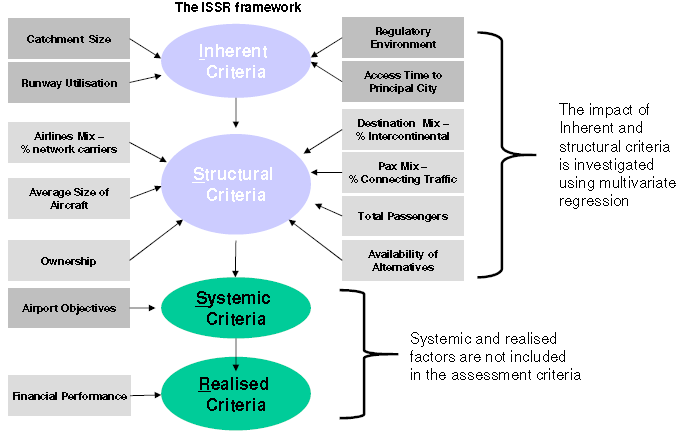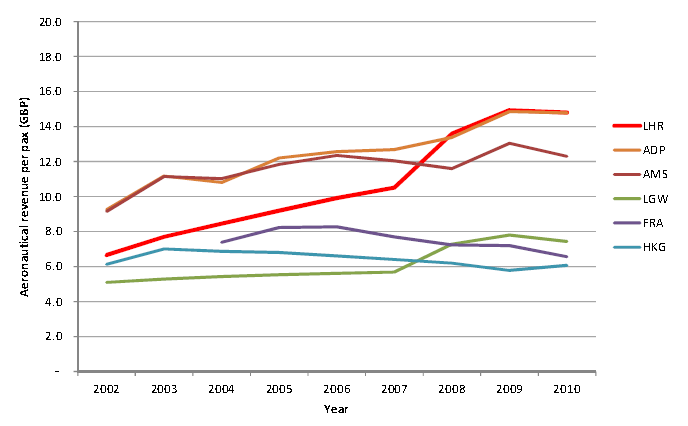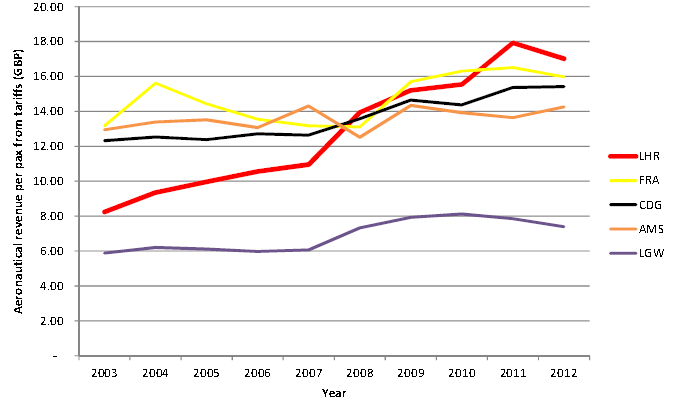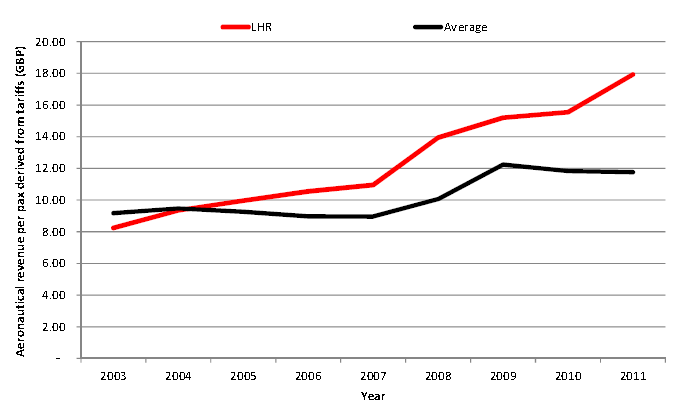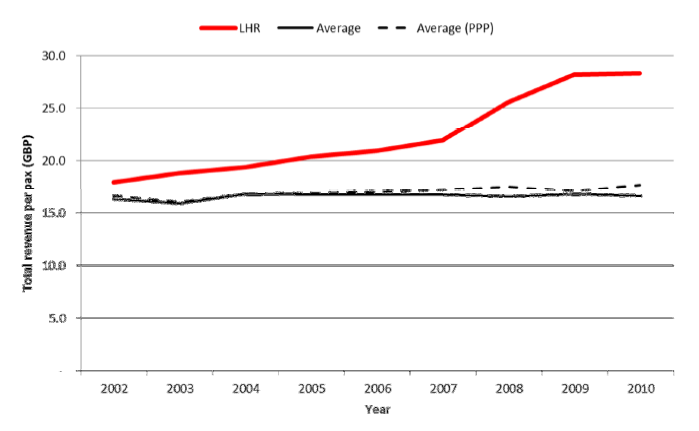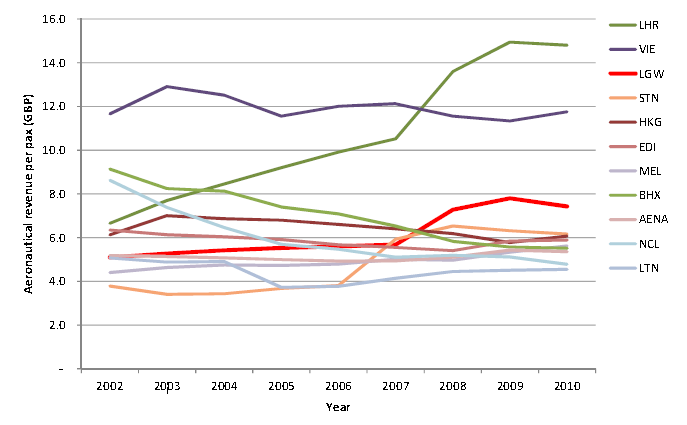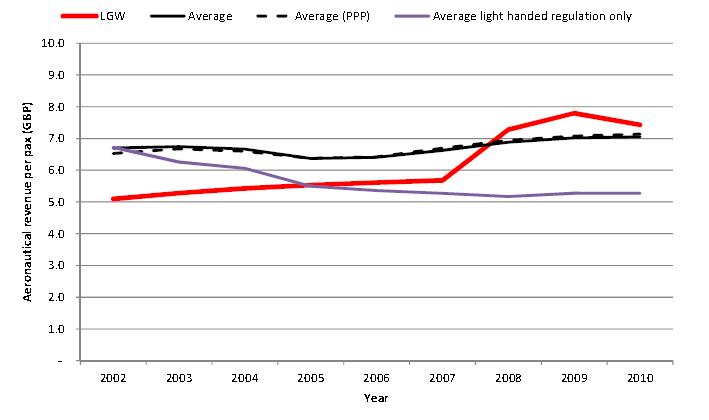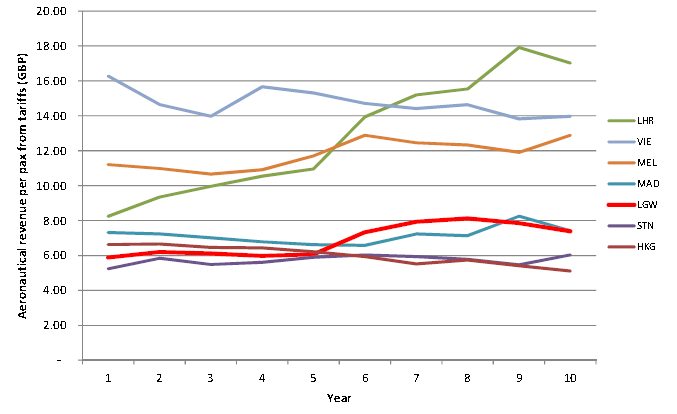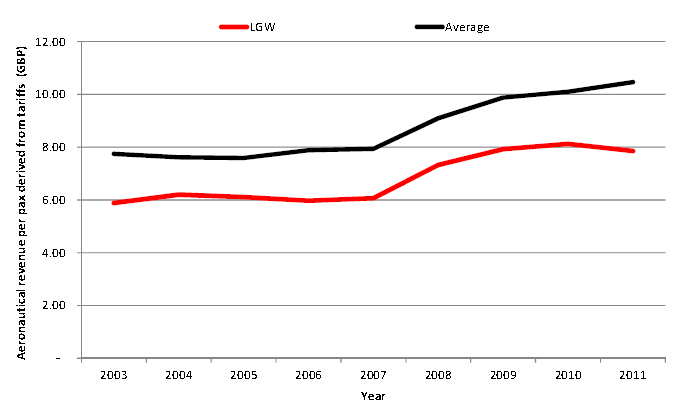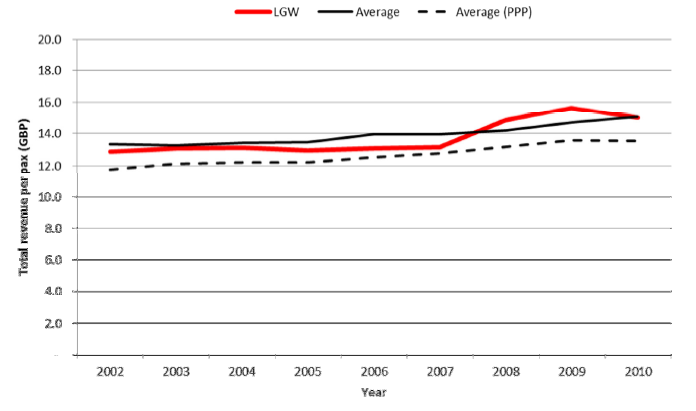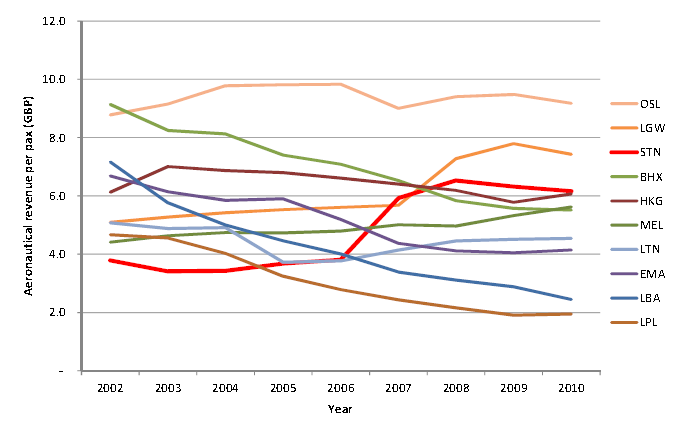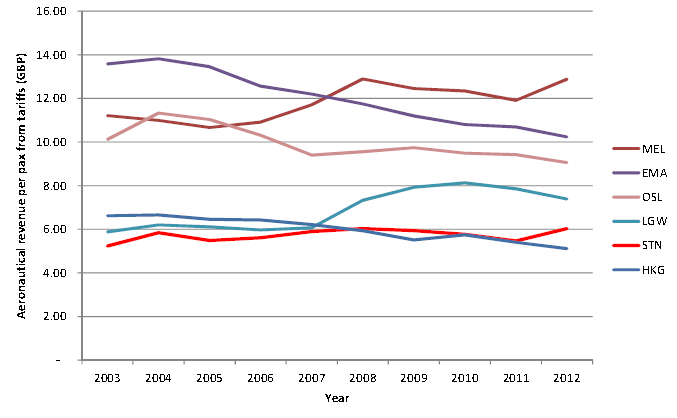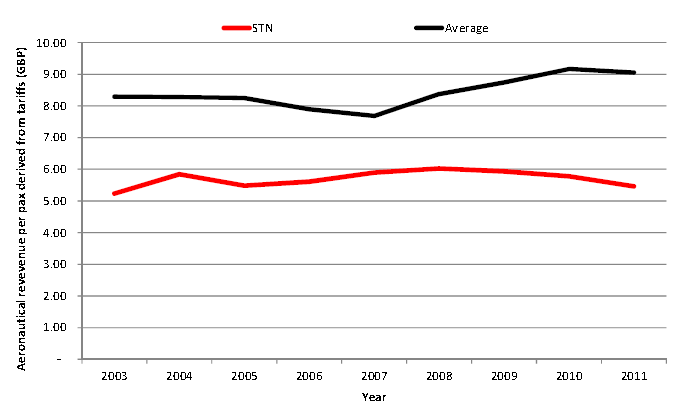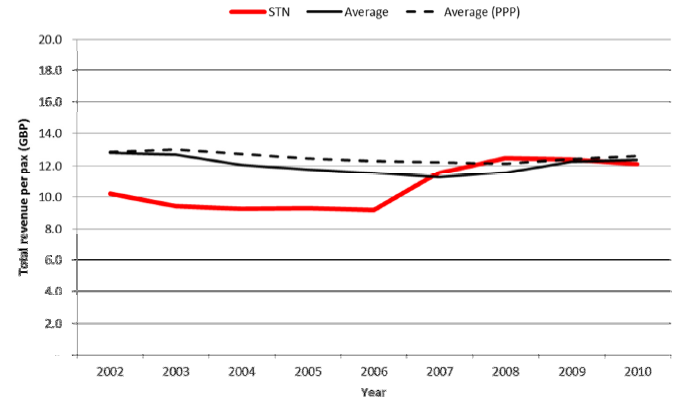CAA’s price proposals for London’s airports: the battle begins as airlines go on the attack
It's a familiar story as we approach the next five-year regulatory period for airport charges at London's Heathrow, Gatwick and Stansted airports starting from Apr-2014. The airports seek big price increases, while the airlines want them cut and the Civil Aviation Authority (the regulator) tries to make proposals in the middle that displease both sides. A CAA-commissioned study shows that all three airports have significantly increased their realised airport charge yield over the past decade and are above the averages of their comparator airport baskets.
The CAA's initial proposals were met on 30-Apr-2013 with immediate howls of displeasure from airline chiefs describing the proposed Gatwick price increases as "completely unjustifiable, totally unacceptable", referring to Stansted's "absolute pricing power" and calling Heathrow "over-priced, over-rewarded and inefficient". For their part, the airports complained about "heavy handed regulation", fearing that the proposals "will put passenger service at risk by not attracting the necessary investment".
- The Civil Aviation Authority (CAA) has published its initial proposals for the price regulation of airport charges at London's Heathrow, Gatwick, and Stansted airports for the next five-year period starting in April 2014.
- The CAA's proposals include a price cap of RPI -1.3% for Heathrow, RPI +1% for Gatwick, and a "price monitoring regime" for Stansted.
- Airlines have criticized the proposed price increases, with British Airways calling Heathrow "over-priced, over-rewarded, and inefficient" and Ryanair calling for a reduction in charges at Stansted.
- The CAA's proposals aim to strike a balance between the airports' desire for increased charges to support investment and the airlines' demand for lower charges.
- A study commissioned by the CAA shows that all three airports have significantly increased their realized airport charge yield over the past decade and are above the averages of their comparator airport baskets.
- The study also reveals that Heathrow has the highest charges, Gatwick is in the middle, and Stansted has the lowest charges among the three airports.
The CAA proposals in summary
The UK's Civil Aviation Authority (CAA) published in late Apr-2013 its initial proposals on the price regulation of airport charges at the three main London airports, Heathrow, Gatwick and Stansted for the five year period starting in Apr-2014 (this period is known as the sixth quinquennium, or Q6).
These proposals are subject to consultation from interested parties, but come after an already extensive period of preliminary work involving the airports and airlines. They will be followed by final proposals and further consultation in Oct-2013.
The CAA's proposals on setting the weighted average cost of capital (WACC) and the price caps, based on the Retail Price Index (RPI) are summarised in the table below and presented in more detail thereafter.
Summary of CAA proposals for price regulation in Q6**
|
Q5* price cap |
CAA initial proposals Q6** |
|||||
|---|---|---|---|---|---|---|
|
Q5
|
Year 1 |
Subsequent years |
WACC |
Price
|
Notes |
|
|
6.2% |
RPI +23.5% |
RPI +7.5% |
5.35% |
RPI -1.3% |
||
|
6.5% |
RPI +21.0% |
RPI +2% |
5.65% |
RPI +1% |
CAA price cap approach to continue
|
|
|
7.1% |
RPI +0% |
RPI +1.63% |
6.0%-6.5% |
RPI/2 |
Price monitoring regime proposed.
|
|
Heathrow: continue with RAB-based price cap
The CAA believes that competition faced by Heathrow Airport is quite limited, and its degree of market power is the strongest of the three airports. The Authority proposes to continue with regulation based on a Regulatory Asset Base (RAB), enhanced with what it calls "stronger incentives to improve efficiency".
Heathrow Airport proposed to the CAA an increase of RPI+5.9%, while its biggest customer British Airways, supported by other airlines, would like to see RPI-9.8%. These two proposals would lead to dramatically different average charges by the end of Q6. In 2011/2012 prices, by the end of 2018/2019, HAL is proposing an average charge per passenger of £27.30 compared to the airlines' proposal of £12.56 - a difference of over 50%. As the CAA rightly recognises, "the airport and the airlines […] fundamentally disagree on the level of operational efficiency and the size of the reward for Heathrow's capital providers".
The CAA's proposed price cap attempts to tread a path between the two sides, reflecting the fact that Heathrow's charges have increased significantly in recent years to pay for large scale infrastructure development, while "continuing to ensure passengers are provided a reasonable service at a world-class airport". Under the CAA's initial proposals, Heathrow's charges would fall over the next five years in real terms, based on a cap of RPI -1.3%.
Heathrow's airlines want lower prices; the airport wants more, to support investment
Not surprisingly, senior representatives of the UK's biggest airlines at Heathrow were quick to denounce the CAA's proposal. Virgin Atlantic CEO Craig Kreeger said "Although today's recommendations from the CAA are a welcome step [...] we believe they should have gone even further. This move compounds the huge increases that passengers have endured in recent years with prices at Heathrow already triple the level they were ten years ago" (The Telegraph, 30-Apr-2013).
Willie Walsh, CEO of British Airways parent company IAG was less conciliatory, declaring that "Heathrow Airport is over-priced, over-rewarded and inefficient and these proposals, which will result in an increase in prices, fail to address this situation". In his view, the CAA has rewarded Heathrow for inefficiency in the past: "it is now the most expensive hub airport in the world. Its charges have tripled in the last 11 years with inflation busting increases year-on-year".
It is, however, interesting to note BA's accumulation of a growing portfolio of slots at Heathrow over many years and the apparent strength of the market in trading slots at the airport.
See related report: Heathrow Airport's slot machine: hitting the jackpot again?
A Heathrow spokesperson said: "We will examine the CAA's proposals for Heathrow's Q6 regulatory settlement carefully over the coming weeks before responding fully. […] Our first impression is that a 5.35% return on capital will put passenger service at risk by not attracting the necessary investment in Heathrow for the short, medium and long term. We, and everyone interested in the health of our country's transportation infrastructure, must consider whether this is a risk worth taking".
Gatwick: keeps RAB-based price cap approach if the airport fails to agree terms with airlines
The CAA also believes that Gatwick has market power, although less than Heathrow. The CAA views a 'Contracts and Commitments' approach as preferable to RAB-based price cap in an ideal world. To this end, it would like to encourage airport-airline discussions as an important factor in the airport's future development and in agreeing prices. It points to the diversity of airline requirements at Gatwick and suggests that a closer working relationship would follow commercial norms seen at non-regulated airports.
Gatwick has taken the initiative to make commitments to its airlines on price and service quality, but, to ensure this new regime works to the benefit of passengers, the commitments would be supplemented with a basic licence from the CAA setting out various service requirements. However, in the CAA's view, "the commitments so far offered by the airport do not seem to the CAA to offer sufficient user benefit to be more effective than traditional regulation".
The regulator is calling on Gatwick to revise its commitments, in particular by reducing its proposed price increase of RPI+6.9% over the next five years (followed by RPI+0%, giving RPI+4% over seven years). The airlines at Gatwick compiled an alternative business plan with a forecast price cap of RP-9%. In the absence of revised proposals from the airport to the CAA's satisfaction, the CAA plans to "default to the same type of price cap that is used at the moment", with a price cap set at RPI +1% for five years (RPI+0% over seven years).
Gatwick's airlines want a lower cap; Gatwick doesn't want one at all
IAG's Mr Walsh was again in combative mood on hearing of the CAA's Gatwick proposals, saying that they will result in a significant increase in charges and "are completely unjustifiable, totally unacceptable and directly contravene the CAA's new remit to represent customers' interests. The CAA must not be allowed to fail again. In line with its new remit, Dame Deirdre Hutton and the CAA board should protect customers and ensure that they get a better deal. We will make strong representations to Dame Deirdre and the board to reconsider this proposal."
easyJet, the biggest carrier at Gatwick, took a more measured line, welcoming the CAA's announcement that it views Gatwick as a monopoly airport and agreeing in principle with the CAA's new approach to regulation. In a statement on 30-Apr-2013, the LCC said that continued regulation of Gatwick would protect the interests of all passengers who use the airport, adding that "easyJet's preference is always to engage constructively with airports to reach commercial agreements which are in both parties' interests - and the interests of passengers - and so agrees in principle at Gatwick. However, despite easyJet's efforts to achieve such an agreement with Gatwick we were unable to reach a mutually agreeable commercial deal."
easyJet argued that the proposed charge increase of RPI +1% appeared to be driven by capital expenditure that doesn't provide value for money for passengers and an unreasonably high cost of capital. It said that it will respond to the CAA asking for it to reduce the proposed charges.
For its part, Gatwick called the proposed RPI+1% price cap "too demanding", adding that it is based on "unrealistic assumptions". Stewart Wingate, Gatwick chief executive said: "London Gatwick's transformation over the last three years has shown that separate ownership and the competition that this has brought, has been good for passengers and airlines. The CAA must not hold us back through imposing heavy handed regulation, red-tape in the form of a licence and an inflexible price control, but should allow us to build on this success."
It is not easy to see how the Gatwick situation will resolve itself. The airport, and the regulator, would like to see the 'Commitments and Contracts' approach succeed, but the airlines are not happy with the terms proposed by Gatwick, presumably because (among other things) the price increases intrinsically contained in them are too high for the airlines. The airlines may also object to the proposed RPI+1% price cap if this approach cannot be made to work, and Gatwick objects to it for different reasons, but it may be better for the airlines than the higher increases sought by the airport.
Stansted: to adopt a 'price monitoring' regime (but there is still a price cap really)
The CAA is taking a more radical view of price regulation at Stansted. It considers that Stansted's market position means that the question of whether it should be regulated at all is more marginal than at the other two airports. In the past five years annual traffic has fallen from 24 million to 17 million passengers and Stansted has some spare capacity (unlike the other two airports).
Nevertheless, the CAA believes it may have market power now and expects this to strengthen over the next five years, as capacity constraints in the London area tighten. The CAA notes uncertainties arising from the change of ownership of Stansted (it was sold by BAA to Manchester Airports Group in Mar-2013) and the dependence of any tightening of capacity constraints on the performance of the UK economy.
The CAA proposes to move away from a fixed price cap approach at Stansted and to replace this with a "price monitoring regime". Under this proposed new approach, Stansted would be required to report information to enable the CAA to produce an annual report on its performance, which would highlight any areas of regulatory concern.
The CAA rather dilutes the novelty of this approach, by also proposing a 'show cause' trigger on price increases of half RPI (RPI/2). This means that, if Stansted were to breach the trigger by increasing prices by more than RPI/2, it would have to 'show cause' and to justify its performance to the CAA's satisfaction. The CAA could then consider "more intrusive and tighter regulatory options". If the CAA were then to conduct a full investigation and not be satisfied with Stansted's explanation or proposals, there would be an automatic price freeze.
The CAA says that this arrangement is "aimed at ensuring that more of the discussion about airport prices and service quality moves into the commercial arena", but the mention of the RPI/2 'show cause' trigger is likely to be viewed by Stansted as the allowable price increase. While this would mean price declines in real terms, it is unlikely to satisfy airlines after the significant increases of recent years. With RPI running in excess of 3% and the Bank of England predicting that it will rise further, the effective proposed price cap is more generous that that proposed for Heathrow.
Stansted airlines (i.e. Ryanair) do not trust this proposed new approach
Stansted's largest airline Ryanair called on the CAA to do more to tackle what it called "excessive airport charges and falling passenger numbers", referring to "the doubling of charges at Stansted in the last 5 years, which has led to a dramatic 25% traffic collapse". Ryanair believes that the proposed price monitoring regime does nothing to constrain Stansted's "absolute pricing power over its airline users and passengers".
Ryanair CEO Michael O'Leary proposed that airport charges at Stansted reduce by RPI-10% every year for the next five years, bringing charges closer to competitive levels and leading to traffic recovery and growth at Stansted. "We also call on Stansted's new owners, Manchester Airport Group, to support this sensible and rational proposal which will allow Stansted airport to grow by allowing airlines to offer passengers a greater choice of routes and lower fares out of Stansted", he added.
Unlike BA's complaining about Heathrow charges, Ryanair has backed up its opposition to charge increases at Stansted by cutting its capacity there in recent years (leading to what it called the "collapse" in traffic).
Comparing charges with comparator airports
In a study prepared for the Civil Aviation Authority in Dec-2012, consultants Leigh Fisher compared airport charges at each of Heathrow, Gatwick and Stansted with those of comparator airports in the UK, Europe and elsewhere. The criteria for choosing the basket of comparator airports included inherent factors such as the catchment size, runway utilisation, regulatory environment and access time to the principal city; and structural factors such as the total number of passengers, mix of network carriers/LCCs, average aircraft size, destination mix and the availability of alternative airports.
Criteria for assessment of comparator airports
The study compared airport charges in two ways: by calculating the realised yield (reported aeronautical revenue per passenger actually received) and by deriving an average charge per passenger from published tariffs for six representative different aircraft types. The differences in the results from these two approaches mainly reflect the level of price discounting offered by the airports from the published tariff and, for this reason, the realised yield approach is more relevant. The study also looked at total revenue per passenger in order to take account of the single till regulatory approach applied in the UK.
For each of these three analyses, Leigh Fisher derived time series from 2002 to 2010 comparing the revenue per passenger at each of the three London airports with the airports in their comparator basket and with the average of the comparators. There was also a comparison with the average of those airports categorised as having "light-handed regulation", i.e. where there is no explicit price cap and airports are allowed discretion in how to meet regulatory targets. The study found that airports subject to price cap regulation have a price roughly GBP2.60 higher than airports in other regulatory environments.
The realised aeronautical revenue per passenger yield approach showed that from 2002 to 2012, Gatwick moved from being towards the lower end to middle of the range of its comparators, Stansted moved from being the lowest to being above average against its comparators and Heathrow moved from second lowest to equal highest in its basket. As would be expected from their relative market powers, Heathrow has the highest charges of the three and Stansted the lowest. Gatwick is between the other two, but much closer to Stansted than to Heathrow. The results are presented in more detail below.
Heathrow's realised prices have more than doubled
Heathrow's realised yield of aeronautical revenue per passenger more than doubled between 2002 and 2010, underlining its strong market pricing power. It moved from having the third lowest aeronautical revenue per passenger to the equal highest in the basket, level with Aéroports de Paris (ADP). Its basket of comparators now consists of two groups: the high charging Heathrow, ADP and Amsterdam and the lower priced Gatwick, Frankfurt and Hong Kong.
Aeronautical revenue per passenger for the Heathrow comparator basket: 2002 to 2010
Heathrow aeronautical revenue per passenger compared to the basket average: 2002 to 2010
Heathrow shows a similar pattern on revenue per passenger derived from tariffs as on the aeronautical yield approach, suggesting that discounting has not played an important role. It has moved from having the second lowest average tariff to the highest in the basket. Heathrow is relatively close to its three main European hub comparators (CDG, FRA and AMS) with Gatwick having much lower charges (reflecting the more business-oriented passenger mix at Heathrow versus Gatwick).
Note in this case, the results for FRA actually represented Frankfurt Airport itself, whereas the results reported in the aeronautical revenue based approach reflect the Fraport Group.
Aeronautical revenue per passenger derived from tariffs for the Heathrow comparator basket: 2003 to 2012
Heathrow aeronautical revenue per passenger derived from tariffs compared to the basket average: 2003 to 2011
On total revenues, Heathrow has consistently been ahead of its comparators, with the gap between it and the basket average growing over the period. This gap is greater for overall revenue per passenger than for aeronautical revenue, suggesting that Heathrow is outperforming on commercial revenues.
Heathrow total revenue per passenger compared to the basket average: 2002 to 2010
Gatwick's yield is 50% above airports with light-handed regulation
On the basis of the aeronautical revenue approach Gatwick's average charge per passenger increased by around 50% from 2002 to 2010. It moved from being towards the lower end in 2002 to the middle of the range of its comparators in 2010 and from below to slightly above the average.
The average derived solely from the airports in the basket that are subject to light-handed regulation (i.e. airports that could be considered to be operating in a competitive market) is much lower than that of the complete sample. Moreover, while Gatwick's yield has increased, the light-handed regulation airports have seen theirs fall over the period so that Gatwick is now around 50% above them.
It could be argued that this light-handed average is a better reflection of the competitive price for an equivalent airport, but this could also reflect other factors such as the degree of capacity utilisation.
Aeronautical revenue per passenger for the Gatwick comparator basket: 2002 to 2010
Gatwick aeronautical revenue per passenger compared to the basket average: 2002 to 2010
On the basis of the tariff approach, Gatwick's aeronautical revenue per passenger has consistently been at the bottom of the comparator basket. This is a different result from that coming from the previous approach based on aeronautical revenue per passenger. This suggests Gatwick has reduced the level of discounting from the published tariffs and has been able to increase aeronautical revenue by pricing to the CAA cap.
Aeronautical revenue per passenger derived from tariffs for the Gatwick comparator basket
Gatwick aeronautical revenue per passenger derived from tariffs compared to the basket average
Gatwick's position on total revenue per passenger is similar to that for aeronautical revenue per passenger, towards the middle of the sample and it has followed the comparator average closely throughout 2002-2010, although its evolution of total revenue per passenger is flatter than its evolution of aeronautical revenue per passenger. Gatwick appears to be achieving the total revenue that might be expected for an airport of its characteristics, albeit with marginally higher aeronautical revenue and marginally lower commercial revenue.
Gatwick total revenue per passenger compared to the basket average: 2002 to 2010
Stansted is the least expensive of the three, but is now above average against its own comparators
From 2002 to 2010, Stansted's aeronautical revenue per passenger increased by more than 50% as it moved from having the lowest charges to having above average charges against its comparators. Most of the increase came in 2007, although it consistently had the lowest aeronautical revenue per passenger derived from tariffs.
This suggests that, from 2007, it has reduced the level of discounting from published tariffs and that its market power has grown.
Aeronautical revenue per passenger for the Stansted comparator basket: 2002 to 2010
Stansted aeronautical revenue per passenger compared to the basket average: 2002 to 2010
Aeronautical revenue per passenger derived from tariffs for the Stansted comparator basket: 2003 to 2012
Stansted aeronautical revenue per passenger derived from tariffs compared to the basket average: 2003 to 2011
Stansted looks similar on overall revenues as on aeronautical, although it has grown more slowly and has been close to the average of its comparators in the recent years (rather than above average as it is on aeronautical revenues).
While its total revenues are at the level expected, the balance of commercial revenues is slightly lower and aeronautical revenue slightly higher. Stansted used to charge well below its price cap but has moved closer to its cap. As with Gatwick, its commercial revenue has not increased in line with aeronautical revenue.
Stansted total revenue per passenger compared to the basket average: 2002 to 2010
